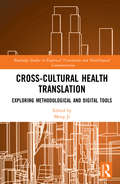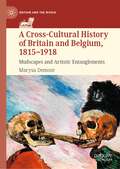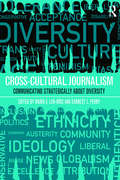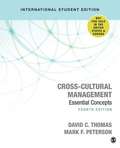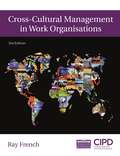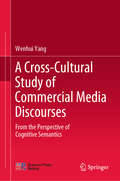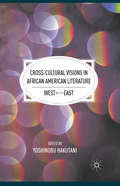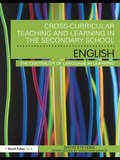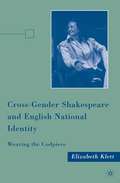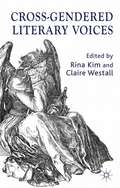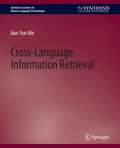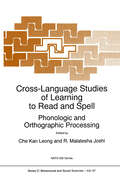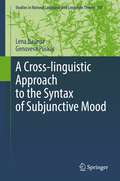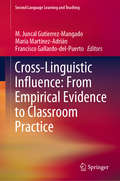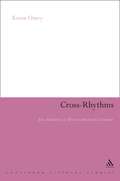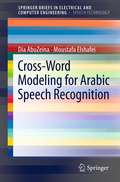- Table View
- List View
Cross-Cultural Health Translation: Exploring Methodological and Digital Tools (Routledge Studies in Empirical Translation and Multilingual Communication)
by Meng JiHealth translation represents a critical yet underexplored research field in Translation Studies. High-quality health translation represents an integral part in the development of multicultural health resources. The empirical study and evaluation of health translations, and the establishment of effective health translation methods and models, holds the key to the success of multicultural health communication and promotion. Chapters in this book aim to fill in a persistent knowledge gap in current multicultural health research, that is, culturally effective and user-oriented healthcare translation. Research presented in this book points to an important opportunity to improve and enhance current multicultural healthcare services based on empirical, evidence-based health translation studies. Health translation provides a powerful intervention tool to engage with migrants with diverse language, cultural backgrounds and health literacy levels. This book provides much-needed reading in the emerging research field of healthcare translation. It makes useful and original contributions to this emerging research field through the exploration of culturally effective health translation methods, approaches and models, as well as the development and evaluation of digital health translation resources and tools.
A Cross-Cultural History of Britain and Belgium, 1815–1918: Mudscapes and Artistic Entanglements (Britain and the World)
by Marysa DemoorThis book highlights the ways in which Britain and Belgium became culturally entangled as a result of their interaction in the period between the Napoleonic Wars and the First World War. In the course of the nineteenth century, the battlefields of Waterloo and Ypres in Belgium became veritable burial grounds for generations of dead British military, indirectly leading to the most intensive ties between the two countries. By exploring this twofold path, the author uncovers a series of cross-influences and creative similarities within the Belgo-British artistic community, and explores the background against which the British national identity was constructed. Revealing unknown links between some of the most famous artists on both sides of the channel, such as D.G. Rossetti and Jan Van Eyck; Christina Rossetti and Fernand Khnopff; John Millais and Pieter Breughel, and Lewis Carroll and Quentin Massys, the book emphasises an artistic cross-fertilisation that can be found within battlefield literature throughout the nineteenth century, including examples from the likes of William M. Thackeray, Frances Trollope and Charlotte Brontë. Providing a rich intercultural history of Belgo-British relations after the battle of Waterloo, this interdisciplinary book will appeal to scholars and students researching history, literature, art and cultural studies.
Cross-Cultural Journalism: Communicating Strategically About Diversity
by Maria Len-Rios Earnest PerryBuilt on the hands-on reporting style and curriculum pioneered by the University of Missouri, this introductory textbook teaches students how to write about and communicate with people of backgrounds that may be different from their own, offering real-world examples of how to practice excellent journalism and strategic communication that take culture into account. Specifically, the book addresses how to: engage with and talk across difference; identify the ways bias can creep into our communications, and how to mitigate our tendencies toward bias; use the concept of fault lines and approach sources and audiences with humility and respect; communicate with audiences about the complexity inherent in issues of crime, immigration, sports, health inequalities, among other topics; interpret census data categories and work with census data to craft stories or create strategic campaign strategies; reconsider common cultural assumptions about race, class, gender, identity, sexual orientation, immigration status, religion, disability, and age, and recognize their evolving and constructed meaning and our role as professional communicators in shaping national discussions of these issues. In addition to its common sense, practical approach, the book’s chapters are written by national experts and leading scholars on the subject. Interviews with award-winning journalists, discussion questions, suggested activities, and additional readings round out this timely and important new textbook. Supplemented by additional case studies and examples of best practice, Cross-Cultural Journalism offers journalists and other communication professionals the conceptual framework and practical know-how they need to report and communicate effectively about difference.
Cross-Cultural Journalism: Communicating Strategically About Diversity
by Maria Len-Rios Earnest PerryBuilt on the hands-on reporting style and curriculum pioneered by the University of Missouri, this introductory textbook teaches students how to write about and communicate with people of backgrounds that may be different from their own, offering real-world examples of how to practice excellent journalism and strategic communication that take culture into account. Specifically, the book addresses how to: engage with and talk across difference; identify the ways bias can creep into our communications, and how to mitigate our tendencies toward bias; use the concept of fault lines and approach sources and audiences with humility and respect; communicate with audiences about the complexity inherent in issues of crime, immigration, sports, health inequalities, among other topics; interpret census data categories and work with census data to craft stories or create strategic campaign strategies; reconsider common cultural assumptions about race, class, gender, identity, sexual orientation, immigration status, religion, disability, and age, and recognize their evolving and constructed meaning and our role as professional communicators in shaping national discussions of these issues. In addition to its common sense, practical approach, the book’s chapters are written by national experts and leading scholars on the subject. Interviews with award-winning journalists, discussion questions, suggested activities, and additional readings round out this timely and important new textbook. Supplemented by additional case studies and examples of best practice, Cross-Cultural Journalism offers journalists and other communication professionals the conceptual framework and practical know-how they need to report and communicate effectively about difference.
Cross-cultural Management: Essential Concepts (PDF)
by David C. Thomas Mark F. PetersonCross-Cultural Management: Essential Concepts introduces readers to the fundamentals of cross-cultural management by exploring the influence of culture on interpersonal interactions in organizational settings and examining the ever-increasing number of cross-cultural challenges that global managers face in today’s workplace. The Fourth Edition reflects the most current thinking on the topic.
Cross-Cultural Management in Work Organisations
by Ray FrenchCross-Cultural Management is the essential introduction to cross-cultural social relations in the work setting. Alternate ISBNS 9781843981497 9781843982432
A Cross-Cultural Study of Commercial Media Discourses: From the Perspective of Cognitive Semantics
by Wenhui YangThis book decodes commercial news discourses from the perspective of cognitive semantics. It attaches considerable importance to the bodily experientialism and linguistic embodiment advocated in discourse analysis and cognitive linguistics and explores the complex yet thought-provoking correlation between overt language and covert cognition by focusing on contrastive analyses of metaphors, image schemas, and stance markers in texts. On the basis of the analyses, the author discusses the linguistic applications, lexical devices and personal experiences, along with their embodied mechanisms, revealing the linguistic strategies, embodied cognitive linguistic actions and constructive thoughts used in media discourses on product promotion, human resources deployment, and commodity problem resolution. In turn, this sheds light on how linguistic selections and cognitive mechanisms are used in composing media news and on how public cognition on certain social and business issues might be framed.The combination of cognitive semantics and commercial discourse analysis offers comprehensive and rewarding insights into the cross-cultural research of both cognitive actions and linguistic behavior reflected in news reports and highlights the correlation between the use of wording and cognitive construction in discourses, which broadens the scope of discourse analysis, cognitive linguistics, applied linguistics, and sociolinguistics. Further, the use of analytical measures and the effective integration of discourse analysis and cognitive semantics lend the book additional analytical authenticity, providing an empirical foundation for cross-cultural communication studies.
Cross-Cultural Visions in African American Literature: West Meets East
by Yoshinobu HakutaniThe most influential East-West artistic, cultural, and literary exchange that has taken place in modern and postmodern times was the reading and writing of haiku. Here, esteemed contributors investigate the impact of Eastern philosophy and religion on African American writers such as Richard Wright, Ralph Ellison, and Toni Morrison, offering a fresh field of literary inquiry.
Cross-Curricular Teaching and Learning in the Secondary School ... English: The Centrality of Language in Learning
by David StevensWhat is the role of the individual school 'subject' and 'subject teacher' within school? Is it to teach a set of core subject knowledge, skills and understanding in a way that remains faithful to long-standing subject cultures and pedagogies? Or is there another way to consider how the curriculum and the notion of individual subjects and teachers' pedagogy could be constructed? Cross-Curricular Teaching and Learning in the Secondary School ... English brings together ongoing debates about personalised learning, creativity and ICT in education to establish a clear theoretical framework for cross-curricular teaching and learning in English and literacy. Presenting an appropriate pedagogy for cross-curricular teaching that draws on this framework, it promotes radical new approaches to English teaching as part of a widened curriculum through practical examples and theoretical discussions, blended with engaging stories of current practice. With links to other curriculum subjects and current education policy, features include: theoretical examination of key issues; assessment of the strengths and weaknesses of different curricular models; clear principles for effective assessment; a wide range of case studies; summaries of key research linked to suggestions for further reading; professional development activities to promote cross-curricular dialogue. Part of the Cross-Curricular Teaching and Learning in the Secondary School series, this timely, interdisciplinary textbook is essential reading for all students on Initial Teacher Training courses and practising teachers looking to holistically introduce cross-curricular themes and practices in secondary English teaching.
Cross-Curricular Teaching and Learning in the Secondary School ... English: The Centrality of Language in Learning
by David StevensWhat is the role of the individual school 'subject' and 'subject teacher' within school? Is it to teach a set of core subject knowledge, skills and understanding in a way that remains faithful to long-standing subject cultures and pedagogies? Or is there another way to consider how the curriculum and the notion of individual subjects and teachers' pedagogy could be constructed? Cross-Curricular Teaching and Learning in the Secondary School ... English brings together ongoing debates about personalised learning, creativity and ICT in education to establish a clear theoretical framework for cross-curricular teaching and learning in English and literacy. Presenting an appropriate pedagogy for cross-curricular teaching that draws on this framework, it promotes radical new approaches to English teaching as part of a widened curriculum through practical examples and theoretical discussions, blended with engaging stories of current practice. With links to other curriculum subjects and current education policy, features include: theoretical examination of key issues; assessment of the strengths and weaknesses of different curricular models; clear principles for effective assessment; a wide range of case studies; summaries of key research linked to suggestions for further reading; professional development activities to promote cross-curricular dialogue. Part of the Cross-Curricular Teaching and Learning in the Secondary School series, this timely, interdisciplinary textbook is essential reading for all students on Initial Teacher Training courses and practising teachers looking to holistically introduce cross-curricular themes and practices in secondary English teaching.
Cross-Gender Shakespeare and English National Identity: Wearing the Codpiece
by E. KlettThis book examines contemporary female portrayals of male Shakespearean roles and shows how these performances invite audiences to think differently about Shakespeare, the English nation, and themselves.
Cross-Gendered Literary Voices: Appropriating, Resisting, Embracing
by Rina Kim and Claire WestallThis book investigates male writers' use of female voices and female writers' use of male voices in literature and theatre from the 1850s to the present, examining where, how and why such gendered crossings occur and what connections may be found between these crossings and specific psychological, social, historical and political contexts.
Cross-Language Information Retrieval (Synthesis Lectures on Human Language Technologies)
by Jian-Yun NieSearch for information is no longer exclusively limited within the native language of the user, but is more and more extended to other languages. This gives rise to the problem of cross-language information retrieval (CLIR), whose goal is to find relevant information written in a different language to a query. In addition to the problems of monolingual information retrieval (IR), translation is the key problem in CLIR: one should translate either the query or the documents from a language to another. However, this translation problem is not identical to full-text machine translation (MT): the goal is not to produce a human-readable translation, but a translation suitable for finding relevant documents. Specific translation methods are thus required. The goal of this book is to provide a comprehensive description of the specific problems arising in CLIR, the solutions proposed in this area, as well as the remaining problems. The book starts with a general description of the monolingual IR and CLIR problems. Different classes of approaches to translation are then presented: approaches using an MT system, dictionary-based translation and approaches based on parallel and comparable corpora. In addition, the typical retrieval effectiveness using different approaches is compared. It will be shown that translation approaches specifically designed for CLIR can rival and outperform high-quality MT systems. Finally, the book offers a look into the future that draws a strong parallel between query expansion in monolingual IR and query translation in CLIR, suggesting that many approaches developed in monolingual IR can be adapted to CLIR. The book can be used as an introduction to CLIR. Advanced readers can also find more technical details and discussions about the remaining research challenges in the future. It is suitable to new researchers who intend to carry out research on CLIR. Table of Contents: Preface / Introduction / Using Manually Constructed Translation Systems and Resources for CLIR / Translation Based on Parallel and Comparable Corpora / Other Methods to Improve CLIR / A Look into the Future: Toward a Unified View of Monolingual IR and CLIR? / References / Author Biography
Cross-Language Studies of Learning to Read and Spell: Phonologic and Orthographic Processing (NATO Science Series D: #87)
by R. MalateshaJoshi Che KanLeongThe present volume is based on the proceedings of the Advanced Study Institute (AS I) sponsored by the North Atlantic Treaty Organization (NATO) held in Alvor, Algarve, Portugal. A number of scholars from different countries participated in the two-week institute on Cognitive and linguistic aspects of reading, writing, and spelling. The present papers are further versions with modifications and refinements from those presented at the Advanced Study Institute. Several people and organizations have helped us in this endeavor and their assistance is gratefully acknowledged. Our special thanks are to: the Scientific Affairs division of NATO for providing the major portions of the financial support, Dr. L.V. da Cunha of NATO and Dr. THo Kester and Mrs. Barbara Kester of the International Transfer of Science and Technology of the various aspects of the institute; and (ITST) for their help and support the staff of Hotel Alvor Praia for making our stay a pleasant one by helping us to run the institute smoothly.
Cross-Lingual Word Embeddings (Synthesis Lectures on Human Language Technologies)
by Anders Søgaard Ivan Vulić Sebastian Ruder Manaal FaruquiThe majority of natural language processing (NLP) is English language processing, and while there is good language technology support for (standard varieties of) English, support for Albanian, Burmese, or Cebuano--and most other languages--remains limited. Being able to bridge this digital divide is important for scientific and democratic reasons but also represents an enormous growth potential. A key challenge for this to happen is learning to align basic meaning-bearing units of different languages. In this book, the authors survey and discuss recent and historical work on supervised and unsupervised learning of such alignments. Specifically, the book focuses on so-called cross-lingual word embeddings. The survey is intended to be systematic, using consistent notation and putting the available methods on comparable form, making it easy to compare wildly different approaches. In so doing, the authors establish previously unreported relations between these methods and are able to present a fast-growing literature in a very compact way. Furthermore, the authors discuss how best to evaluate cross-lingual word embedding methods and survey the resources available for students and researchers interested in this topic.
A Cross-linguistic Approach to the Syntax of Subjunctive Mood (Studies in Natural Language and Linguistic Theory #101)
by Lena Baunaz Genoveva PuskásThis monograph gives a unified account of the syntactic distribution of subjunctive mood across languages, including Romance, Balkan (South Slavic and Modern Greek), and Hungarian, among others. Starting from a close scrutiny of the environments in which subjunctive mood occurs and of its semantic contribution, we present a feature-based approach which reveals the common properties of the class of verbs which embed subjunctive, and which takes into account the variation in subjunctive-related complementizers. Two main proposals can be highlighted: (i) the lexical semantics of the main clause predicate plays a crucial role in mood selection. More specifically subjunctive mood is regulated by a specific property of the main predicate, the emotive property, which is associated with the external argument of the embedding verb (usually the Subject). The book proposes a nanosyntactic analysis of the internal structure of embedding verbs. (ii) Cross- and intra-linguistic variations are dealt with according to different patterns of lexicalization, i.e., variations depend on what portions of the verb’s and complementizer’s functional sequence is lexicalized and on how it is packaged by languages. In doing so, this approach provides a uniform account of the phenomenon of embedded subjunctives. The monograph takes a novel, feature-based approach to the question of subjunctive licensing, providing a detailed analysis of the features of the matrix verb, of the complementizer and of the embedded subjunctive clause. It is also based on a wide empirical coverage, ranging from the relatively well-studied groups of Romance and Balkan languages to less explored languages from non-Indo-European families (Hungarian).
Cross-Linguistic Influence: From Empirical Evidence to Classroom Practice (Second Language Learning and Teaching)
by M. Juncal Gutierrez-Mangado María Martínez-Adrián Francisco Gallardo-del-PuertoThis book presents the latest research in various areas of cross-linguistic influence (CLI), providing educators with insights into how previously learned languages influence the learning of an additional language at different levels, such as phonetics/phonology, morphosyntax, vocabulary, pragmatics, writing style and learning context. While the majority of the chapters have English as the target language, one investigates the acquisition of French. The L1s of the learners include Arabic, Basque, Catalan, Chinese, Czech, Danish, Finnish, Galician, Georgian, German, Norwegian, Polish, Russian, Spanish and Swedish. Each chapter ends with a reflection on possible pedagogical implications of the findings and offers recommendations on how to make the most of cross-linguistic influence in the classroom.
Cross-linguistic Influences in Multilingual Language Acquisition (Second Language Learning and Teaching)
by Danuta Gabrys-BarkerThis volume depicts the phenomenon of cross-linguistic influences in the specific context of multilingual language acquisition. It consists of articles on various issues relating to the syntactic and lexical development of foreign language learners from different L1 backgrounds, in many cases involving languages which are typologically distant from English, such as Russian, Croatian, Greek and Portuguese. Individual chapters highlight different areas expected to be especially transfer-prone at the level of grammatical and lexical transfer in particular contexts of language contact.
Cross-Linguistic Perspectives on Language Processing (Studies in Theoretical Psycholinguistics #25)
by VincenzoLombardo MaricaVincenziRecent studies in psycho linguistics have ranged through a variety of languages. In this trend, which has no precedent, studies in language processing have followed studies in language acquisition and theoretical linguistics in considering language universals in a broader scope than only in English. Since the beginning of the century, studies in language acquisition have produced a vast body of data from a number of Indoeuropean languages, and the emphasis on the universal has preceded the emphasis on the particular (see (Slobin 1985) for a review). Nowadays, the research in the field advances by means of a continuous linking between the cross-linguistic uniformities and the individual language influences on development. The level of language universals is continuously refined as the data from a number of languages contribute to the elaboration of a more distinctive picture of the language of children. The first cross-linguistic studies in theoretical linguistics appeared at the end of the seventies. Within the Chomskian paradigm, the reference to the Romance languages caused a shift from a rule-based toward a principle-based formalism (Chomsky 1981, 1995); within alternative theories, the reduced prominence of the pure phrase structure component in favor of the lexicon and/or the functional relations (see, e.g., Lexical Functional Grammar (Bresnan 1982), Relational Grammar (Perlmutter 1983)) sought empirical support in languages exhibiting deep structural differences with respect to English (e.g. Bantu, Malayalam, Romance and Slavic languages Warlpiri). The M. De Vincenzi and V. Lombardo (eds.), Cross-linguistic Perspectives on Language Processing, 1-19.
Cross-Linguistic Studies of Imposters and Pronominal Agreement (Oxford Studies in Comparative Syntax)
Imposters are third person DPs that are used to refer to the speaker/writer or addressee, such as : (i) Your humble servant finds the time before our next encounter very long. (ii) This reporter thinks that the current developments are extraordinary. (iii) Daddy will be back before too long. (iv) The present author finds the logic of the reply faulty. This volume explores verbal and pronominal agreement with imposters from a cross-linguistic perspective. The central questions for any given language are: (a) How do singular and plural imposters agree with the verb? (b) When a pronoun has an imposter antecedent, what are the phi-features of the pronoun? The volume reveals a remarkable degree of variation in the answers to these questions, but also reveals some underlying generalizations. The contributions describe imposters in Bangla, Spanish, Albanian, Indonesian, Italian, French, Romanian, Mandarin and Icelandic.
Cross-linguistic Variation And Efficiency
by John A. HawkinsIn this book John A. Hawkins argues that major patterns of variation across languages are structured by general principles of efficiency in language use and communication. Evidence for these comes from languages permitting structural options from which selections are made in performance, e.g. between competing word orders and between relative clauses with a resumptive pronoun versus a gap. The preferences and patterns of performance within languages are reflected, he shows, in the fixed conventions and variation patterns across grammars, leading to a 'Performance-Grammar Correspondence Hypothesis'. Hawkins extends and updates the general theory that he laid out in Efficiency and Complexity in Grammars (OUP 2004): new areas of grammar and performance are discussed, new research findings are incorporated that test his earlier predictions, and new advances in the contributing fields of language processing, linguistic theory, historical linguistics, and typology are addressed. This efficiency approach to variation has far-reaching theoretical consequences relevant to many current issues in the language sciences. These include the notion of ease of processing and how to measure it, the role of processing in language change, the nature of language universals and their explanation, the theory of complexity, the relative strength of competing and cooperating principles, and the proper definition of fundamental grammatical notions such as 'dependency'. The book also offers a new typology of VO and OV languages and their correlating properties seen from this perspective, and a new typology of the noun phrase and of argument structure.
Cross-linguistic Variation in Sentence Processing: Evidence From R C Attachment Preferences in Greek (Studies in Theoretical Psycholinguistics #36)
by Despoina PapadopoulouThis book argues in favour of cross-linguistic variation in sentence processing by providing empirical data from ambiguity resolution in Greek as L1 and L2. It is maintained that in highly inflected languages, like Greek, initial parsing decisions are determined by the interaction of morphological and lexical cues rather than by universal parsing principles.
Cross-Rhythms: Jazz Aesthetics in African-American Literature (Continuum Literary Studies)
by Keren OmryCross-Rhythms investigates the literary uses and effects of blues and jazz in African-American literature of the twentieth century. Texts by James Baldwin, Ralph Ellison, Langston Hughes, Zora Neale Hurston, Gayl Jones, Toni Morrison and Ishmael Reed variously adopt or are consciously informed by a jazz aesthetic; this aesthetic becomes part of a strategy of ethnic identification and provides a medium with which to consider the legacy of trauma in African-American history. These diverse writers are all thoroughly immersed in a socio-cultural context and a literary aesthetic that embodies shifting conceptions of ethnic identity across the twentieth century. The emergence of blues and jazz is, likewise, a crucial product of, as well as catalyst for, this context, and in their own aesthetic explorations of notions of ethnicity these writers consciously engage with this musical milieu. By examining the highly varied manifestations of a jazz aesthetic as possibly the fundamental common denominator which links these writers, this study attempts to identify an underlying unifying principle. As the different writers write against essentializing or organic categories of race, the very fact of a shared engagement with jazz sensibilities in their work redefines the basis of African-American communal identity.
Cross-Rhythms: Jazz Aesthetics in African-American Literature (Continuum Literary Studies)
by Keren OmryCross-Rhythms investigates the literary uses and effects of blues and jazz in African-American literature of the twentieth century. Texts by James Baldwin, Ralph Ellison, Langston Hughes, Zora Neale Hurston, Gayl Jones, Toni Morrison and Ishmael Reed variously adopt or are consciously informed by a jazz aesthetic; this aesthetic becomes part of a strategy of ethnic identification and provides a medium with which to consider the legacy of trauma in African-American history. These diverse writers are all thoroughly immersed in a socio-cultural context and a literary aesthetic that embodies shifting conceptions of ethnic identity across the twentieth century. The emergence of blues and jazz is, likewise, a crucial product of, as well as catalyst for, this context, and in their own aesthetic explorations of notions of ethnicity these writers consciously engage with this musical milieu. By examining the highly varied manifestations of a jazz aesthetic as possibly the fundamental common denominator which links these writers, this study attempts to identify an underlying unifying principle. As the different writers write against essentializing or organic categories of race, the very fact of a shared engagement with jazz sensibilities in their work redefines the basis of African-American communal identity.
Cross-Word Modeling for Arabic Speech Recognition (SpringerBriefs in Speech Technology)
by Dia AbuZeina Moustafa ElshafeiCross-Word Modeling for Arabic Speech Recognition utilizes phonological rules in order to model the cross-word problem, a merging of adjacent words in speech caused by continuous speech, to enhance the performance of continuous speech recognition systems. The author aims to provide an understanding of the cross-word problem and how it can be avoided, specifically focusing on Arabic phonology using an HHM-based classifier.
